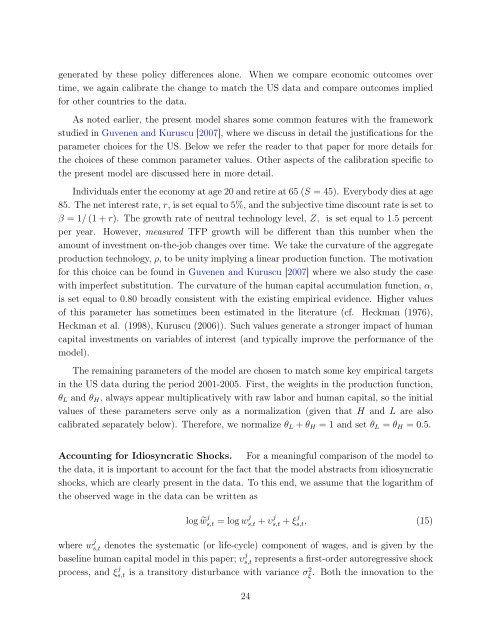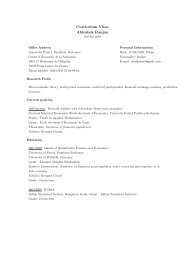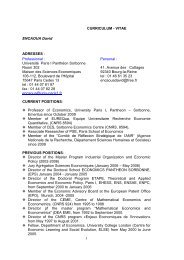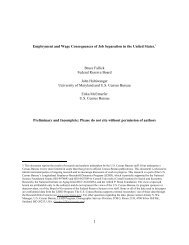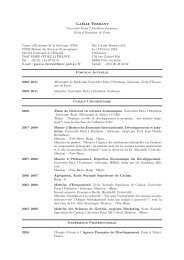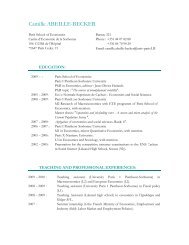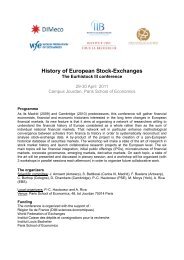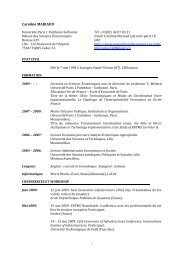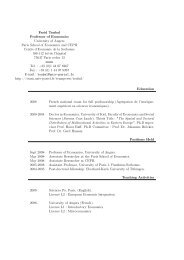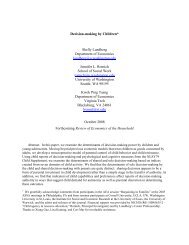info document - Paris School of Economics
info document - Paris School of Economics
info document - Paris School of Economics
You also want an ePaper? Increase the reach of your titles
YUMPU automatically turns print PDFs into web optimized ePapers that Google loves.
generated by these policy differences alone. When we compare economic outcomes overtime, we again calibrate the change to match the US data and compare outcomes impliedfor other countries to the data.As noted earlier, the present model shares some common features with the frameworkstudied in Guvenen and Kuruscu [2007], where we discuss in detail the justifications for theparameter choices for the US. Below we refer the reader to that paper for more details forthe choices <strong>of</strong> these common parameter values. Other aspects <strong>of</strong> the calibration specific tothe present model are discussed here in more detail.Individuals enter the economy at age 20 and retire at 65 (S = 45). Everybody dies at age85. The net interest rate, r, is set equal to 5%, and the subjective time discount rate is set toβ = 1/ (1 + r). The growth rate <strong>of</strong> neutral technology level, Z, is set equal to 1.5 percentper year. However, measured TFP growth will be different than this number when theamount <strong>of</strong> investment on-the-job changes over time. We take the curvature <strong>of</strong> the aggregateproduction technology, ρ, to be unity implying a linear production function. The motivationfor this choice can be found in Guvenen and Kuruscu [2007] where we also study the casewith imperfect substitution. The curvature <strong>of</strong> the human capital accumulation function, α,is set equal to 0.80 broadly consistent with the existing empirical evidence. Higher values<strong>of</strong> this parameter has sometimes been estimated in the literature (cf. Heckman (1976),Heckman et al. (1998), Kuruscu (2006)). Such values generate a stronger impact <strong>of</strong> humancapital investments on variables <strong>of</strong> interest (and typically improve the performance <strong>of</strong> themodel).The remaining parameters <strong>of</strong> the model are chosen to match some key empirical targetsin the US data during the period 2001-2005. First, the weights in the production function,θ L and θ H , always appear multiplicatively with raw labor and human capital, so the initialvalues <strong>of</strong> these parameters serve only as a normalization (given that H and L are alsocalibrated separately below). Therefore, we normalize θ L + θ H = 1 and set θ L = θ H = 0.5.Accounting for Idiosyncratic Shocks. For a meaningful comparison <strong>of</strong> the model tothe data, it is important to account for the fact that the model abstracts from idiosyncraticshocks, which are clearly present in the data. To this end, we assume that the logarithm <strong>of</strong>the observed wage in the data can be written aslog ˜w j s,t = log w j s,t + υ j s,t + ξ j s,t, (15)where w j s,t denotes the systematic (or life-cycle) component <strong>of</strong> wages, and is given by thebaseline human capital model in this paper; υ j s,t represents a first-order autoregressive shockprocess, and ξ j s,t is a transitory disturbance with variance σξ 2 . Both the innovation to the24


